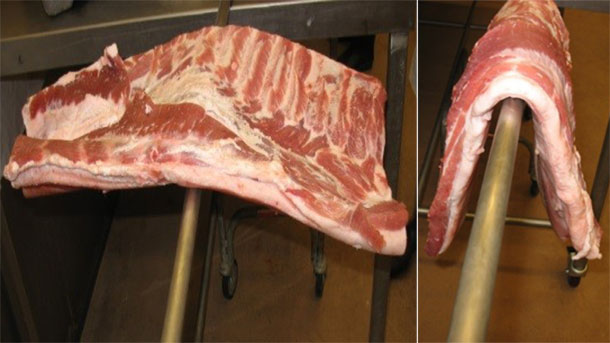The U.S. ethanol industry produces about 38 million metric tonnes of corn co-products annually, of which about 8 million metric tonnes of distillers dried grains with solubles (DDGS) are used in swine diets in the U.S. An additional 11 million tonnes of DDGS are exported to 50 countries where a high proportion of DDGS is used in swine feeds. The greatest proportion of DDGS use in swine feeds is during the growing-finishing phase, and its popularity is a result of its generally low cost as a partial replacement for corn and soybean meal in swine diets. As a result of the significant diet cost savings that DDGS often provides in swine diets, nutritionists strive to maximize diet inclusion rates while maintaining growth performance and carcass quality. However, one of the potential barriers of using high amounts (> 20%) of DDGS in growing-finishing diets is its effects on reducing carcass fat and belly firmness, which can lead to reduced processor and consumer acceptance in some markets.
Corn DDGS is unique compared with other commonly used feed ingredients because it contains between 4 to 12% corn oil. Corn oil contains high concentrations of unsaturated fatty acids, particularly linoleic acid (C18:2). Therefore, when growing-finishing pigs are fed diets containing high amounts of DDGS, with high crude fat content, carcass fat firmness and belly quality is reduced (Figure 1, right) compared with feeding corn-soybean meal diets (Figure 1, left). These effects are greatest in gilts (compared with barrows), and in very lean swine genotypes compared with pigs that have more carcass fat. It is important to note that this effect can also be observed when feeding high dietary amounts of various oils, such as soybean oil, that contain a high proportion of unsaturated fatty acids.


Soft pork fat is a concern because it has a "greasy" or oily appearance at room temperature, and the increased polyunsaturated fatty acid content may result in reduced shelf life of fresh pork products stored for extended periods of time in retail meat cases. Furthermore, soft bellies can cause handling difficulties and reduce slicing yields during belly processing when processing into cured bacon. As a result, there has been considerable research to find ways of optimizing dietary inclusion rates of DDGS to reduce diet cost, while also producing pork carcasses with acceptable pork fat quality.
Although there are no official pork fat quality standards in the U.S., most pork packer/processors consider pork fat quality to be acceptable if it has an iodine value (IV) less than 74. Iodine value is a ratio of the unsaturated to saturated fatty acid content of a lipid. Iodine value is generally calculated from the fatty acid concentrations determined by chemical analysis of lipids, but it can also be directly determined using a specific laboratory analysis procedure. Growing-finishing pigs fed common corn-soybean meal diets often have a backfat IV less than 60, while feeding diets containing 30% of a high-oil (> 10% crude fat) DDGS can often result in carcass back IV greater than 74.
Several diet formulation and feeding strategies have been developed to manage carcass fat and belly quality when feeding DDGS diets to growing-finishing pigs.
1. Use DDGS sources that contain lower oil (crude fat) content to allow greater diet inclusion rates of DDGS while minimizing the total diet unsaturated fatty acid content.
2. Formulate diets using constraints to limit the total amount of polyunsaturated fatty acids consumed by growing-finishing pigs. However, it is important to realize that various carcass fat depots (backfat, jowl fat, and belly fat) respond differently to diet fatty acid composition and amount. Wu et al. (2016) compared the accuracy (prediction error) and precision (bias) of using various diet formulation constraints to achieve desired carcass backfat IV (Table 1). Using prediction equations based on the % DDGS in the diet or the concentration of linoleic acid in the diet generally result in the least accuracy and precision, while prediction equations based on iodine value product content of the diet or IVP consumed per day have greater accuracy and precision. However, to achieve the greatest accuracy and prediction of carcass fat IV, a more complex prediction equation is needed (Paulk et al., 2015).
Table 1. Comparison of prediction equations for estimating iodine value (IV) of carcass backfat, jowl fat, belly fat, and the average IV of the 3 carcass fat depots (adapted from Wu et al., 2016).
| Fat depot | Equation | R2 | Prediction error1 | Bias2 | Reference |
| Backfat | |||||
| 47.1 + 0.14 × IVP3 intake/day | 0.86 | 6.43 | -4.95 | Madsen et al., 1992 | |
| 52.4 + 0.315 × diet IVP | - | 4.60 | -2.15 | Boyd et al., 1997 | |
| 51.946 + 0.2715 × diet IVP | 0.16 | 6.45 | -5.05 | Benz et al., 2011 | |
| 35.458 + 14.324 × diet C18:2, % | 0.73 | 8.36 | -1.08 | Benz et al., 2011 | |
| 64.5 + 0.432 ×DDGS in diet, % | 0.92 | 8.26 | 7.10 | Cromwell et al., 2011 | |
| 60.13 + 0.27 × diets IVP | 0.81 | 5.04 | 3.05 | Estrada Restrepo, 2013 | |
| 70.06 + 0.29 × DDGS in diet, % | 0.81 | 9.19 | 8.00 | Estrada Restrepo, 2013 | |
| 84.83 + (6.87 × IEFA) – (3.90 × FEFA) – (0.12 × Id) – (1.30 × Fd) – (0.11 × IEFA × Fd) + (0.048 × FEFA × Id) + (0.12 × FEFA × Fd) – (0.006 × FNE) + (0.0005 × FNE × Fd) – (0.26 × BF) | 0.95 | 4.01 | -0.84 | Paulk et al., 20154 | |
| Jowl fat | |||||
| 56.479 + 0.247 × diet IVP | 0.32 | 4.92 | -3.69 | Benz et al., 2011 | |
| 47.469 + 10.111 × diet C18:2, % | 0.90 | 5.57 | -1.37 | Benz et al., 2011 | |
| 64.54 + 0.27 × diet IVP | 0.81 | 6.55 | 5.66 | Estrada Restrepo, 2013 | |
| 72.99 + 0.24 × DDGS in diet, % | 0.81 | 8.33 | 7.38 | Estrada Restrepo, 2013 | |
| 85.50 + (1.08 × IEFA) + (0.87 × FEFA) – (0.014 × Id) – (0.05 × Fd) + (0.038 × IEFA × Id) + (0.054 × FEFA × Fd) – (0.00066 × INE) + (0.071 × IBW) – (2.19 × ADFI) – (0.29 × BF) | 0.93 | 4.73 | -3.37 | Paulk et al., 20154 | |
| Belly fat | |||||
| 58.32 + 0.25 × diet IVP | 0.74 | 3.43 | 1.41 | Estrada Restrepo, 2013 | |
| 67.35 + 0.26 × DDGS in diet, % | 0.75 | 6.66 | 5.53 | Estrada Restrepo, 2013 | |
| 106.16 + (6.21 × IEFA) – (1.50 × Fd) – (0.11 × IEFA × Fd) – (0.012 × INE) + (0.00069 × INE × Fd) – (0.18 × HCW) – (0.25 × BF) | 0.94 | 3.27 | 1.73 | Paulk et al., 20154 | |
| Average of 3 depots | |||||
| 58.103 + 0.2149 × diet IVP | 0.93 | 3.93 | -2.23 | Kellner, 2014 | |
| 58.566 + 0.1393 × C18:2 intake/day, g | 0.94 | 6.17 | -4.90 | Kellner, 2014 | |
1Prediction error (smaller value indicates greater precision of the equation)
2Prediction bias (smaller absolute value indicates greater accuracy of the equation; negative value indicates underestimation and positive values indicate overestimation)
3IVP = iodine value product = dietary IV × % dietary lipids × 0.10 (Madsen et al., 1992)
4Abbreviations in equations are: I = initial diet, F = final diet, d = days diet is fed, EFA = essential fatty acids (C18:2 and C18:3, %), NE = net energy (kcal/kg), BW = body weight (kg), ADFI = average daily feed intake (kg), HCW = hot carcass weight (kg), BF = backfat depth (mm)
3. Withdraw DDGS from the diet 3 to 5 weeks before slaughter to allow carcass fat to become more firm.
4. Use wheat and barley as the primary grain sources in DDGS diets instead of corn to minimize the increase in carcass fat IV.
5. It is well documented that adding saturated animal fats to DDGS diets does not result in improved pork fat quality.
6. Effective and GRAS (generally recognized as safe) approved feed additives that are being used to achieve desired pork fat and belly firmness in the U.S. market have been shown to be effective when feeding diets containing high inclusion rates of DDGS.
Conclusions

Feeding corn DDGS diets to growing-finishing pigs can substantially reduce feed cost while maintaining growth performance, but it reduces carcass pork fat firmness. Soft pork fat is a concern in some markets around the world because of its potential negative effects on consumer acceptance, reduced shelf life of fresh pork products, reduced bacon slicing yields, and increased handling challenges. However, acceptable pork fat quality can be achieved by restricting the amount and length of time DDGS is fed by using carcass fat IV prediction equations when formulating growing-finishing pig diets.





